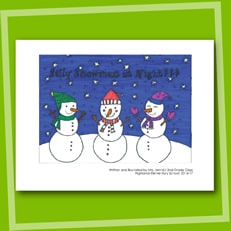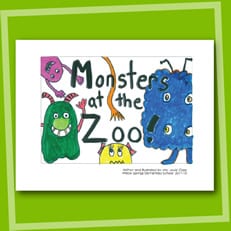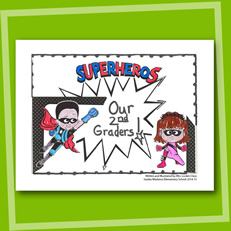 Gone are the days of classrooms with rows and rows of desks and students all facing the teacher.
Gone are the days of classrooms with rows and rows of desks and students all facing the teacher.
Nowadays, classrooms feature everything from tables and chairs to flexible seating. And what these seating styles promote is a collaborative learning environment—perfect for team projects.
Having your students work together to meet a goal gives them a chance to practice compromise, communication and time management. Working together on a classbook, students learn how to assign each other tasks and keep each other accountable to finish their book pages on time.
Creating a Class Book: Teaching Elementary Students About Teamwork
One such project that facilitates all of these learning opportunities is creating a classbook.
By working with your class on the following tasks (and one celebration!), they will complete the necessary steps to create a classbook. A classbook gives the students a permanent reminder of how the class teamed up to accomplish their goal.
Agree on a Concept
Once the students understand that they are creating a book, then, depending on the grade, ask the students for ideas on what to write about in the book. Facilitate a traditional brainstorming session where students raise their hands and provide their thoughts, then you collect the ideas on the chalkboard, smart board or flip chart.
Sometimes teachers might find that only the loudest or easiest ideas are heard due to students shouting over each other or perhaps students not wanting to raise their hands so be sure to check in with any quieter students to make sure everyone’s opinion is heard.
Give all your students five sticky notes and ask them to write down their ideas for a book topic. Then once they are done, post all the ideas on a wall with no names attached. Once everyone reads the ideas, then the class discusses all of the proposed topics and can then decide which one works the best for their book.
Another strategy that fits in perfectly with creating a classbook is “brainwriting.” Simply flip the talking and writing portions of a traditional brainstorm.
PROJECT IDEA
Coming up with a fun and creative concept for your class book is a great time to really show students the power of imagination. Have students complete writing prompts and add illustrations to create their classbooks! The example above ‘Silly Snowmen at Night’ was likely inspired by a recent snowfall and instead of just writing about building a snowman or playing in the snow, this class came up with the idea that snowmen come to life at night and then used their imaginations to write about what those snowmen do at night.
Stick to the Topic
Once students land on a topic for their book, it’s time to start writing. But how does that look for different grade levels?
- If your first graders picked superheroes as their classbook theme, then talk about a variety of superheroes and what it takes to be a superhero.
- Third graders should already be able to follow a writing prompt but might need guidance through the editing and revision process.
- Fourth and fifth graders will be able to handle more complex writing assignments and may be able to edit their work with the help of a peer review.
Pick Cover Art
Allow the students to work as small groups or pairs to dream up cover art for the book. From drawings to photographs, you’ll want to take all the options, and then you can have the class participate in “Save the Last Word for Me” discussion strategy to pick the winning cover art.
Put students into groups. Each student then goes off and draws three images they think would look good on the cover of the classbook and makes notes about why they like each one. Then they will show the cover art images they drew to their group and listen as the other students discuss.
Once the discussion is finished, each group picks an illustration, thus narrowing down the cover art choices for the whole class.
PROJECT IDEA
For this project, brainstorm your concept and encourage students to go further than just writing about the zoo or drawing simple illustrations. Have students choose the cover art collectively and create a classbook that they can share with their families. The cover of ‘Monsters at the Zoo’ was a collaborative effort where a few students drew the class’ chosen monsters.
Creating Your Classbook
Not only will creating a classbook provide an opportunity for your class to work collaboratively, but the book itself becomes a memento—of not only the project but a moment in time.
Your classbook might spark a student’s memory of the fun had when they worked as a team to make the cover art. Or the laughter that happened when the class went over the ideas for the topic. Plus, it captures the student’s writing style from that particular grade. The students and their families will have a memento to look back on as they continue to grow as a writer.
PROJECT IDEA
You can really hammer home the importance of teamwork by having students create a classbook about a team of superheroes. Have students come up with a challenge that their protagonists are facing and then write about how they worked as a team to overcome that challenge. Students then can draw themselves or fictional superheroes to help create a classbook that they can enjoy years down the road.
Meet the Deadline
An important concept of working as a team involves learning how to trust your teammates to accomplish their tasks.
Certainly for the lower grades, K-2nd, you will assign deadlines for turning in their writing exercises and companion drawing—or whatever concept your class picked.
However, if you teach 3rd-6th grade, allowing the students to work in smaller teams to put together spreads gives them a chance to assign work to certain students and experience trusting classmates to finish their homework.
Celebrating the final product
What team doesn’t want to celebrate once they achieve a goal?
The same holds true for kids—they love a good party. And after all the hard work they’ve done together to create their classbook, they’ll enjoy a fun party.
When the classbooks arrive, hold a party and pass out the books, giving all the students a chance to admire all their work and those of their classmates.
In fact, the party offers up another chance for the students to work together—ask them to plan the event; from who brings the food to who puts up the decorations. Just one more teamwork opportunity for your class!
Turn Your Students into Published Authors
When you order your FREE classbook publishing kit, you’ll receive everything you need to turn your students into published authors, including:
- 66 Kit Pages: 33 for Text & 33 for Illustration
- Cover, Title, Dedication and Author Page
- A Student-Created Sample Book
- Step-by-Step Teacher Guide
- Replacement Materials
- Parent Order Forms
- A FREE, deluxe hardcover copy of your classbook for the teacher an option for parents to purchase copies, too!
Looking for more ways to help your students with writing? Check out our online teacher’s lounge, where you’ll find helpful ideas and more.








